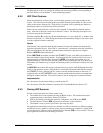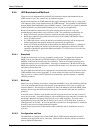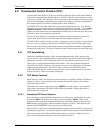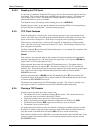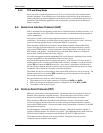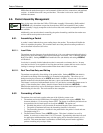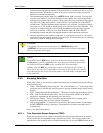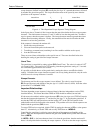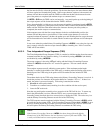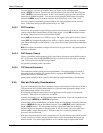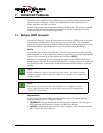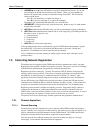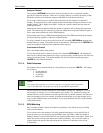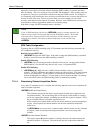
User’s Guide Protocols and Packet Assembly Features
2110212 Rev 1.0 Page 49
the line must be idle for at least the guard time. By the time that elapses, the inter-character timer
will have expired and forwarded the packet. If the escape character sequence is then started, the
modem will hold the new buffer until the TDES has either been broken (the characters become
part of the packet) or completed (the modem escapes to command state).
If +WS70 > S12 then the TDES can be used normally. Any partial packet up to the beginning of
the escape sequence will be forwarded when the TDES is detected.
Cases where the buffer is within one or two characters of reaching its maximum length (+WS74)
are protected. Whenever a partial packet exists and the TDES is started, the modem will hold the
buffer until the TDES has either been broken (the characters become part of the packet) or
completed (the modem escapes to command state).
If the sequence starts with the first escape character in the last available buffer position, the
modem will hold the packet as just described. If the second escape character is received in
sequence but then the sequence is broken, the packet up to and including the first escape character
will be forwarded and a new buffer is started with the second escape character and all subsequent
data.
In rare cases where the packet Primary Forwarding Character (+WS64) is set to the plus sign, the
user is strongly advised to alter the escape character (S2) to something else. If this is not done,
TDES will be unavailable.
6.6.3.2. Time Independent Escape Sequence (TIES)
The Time Independent Escape Sequence (TIES) is a method to shift the modem from data state to
command state that does not depend on timing. It is enabled by setting +WS60=1 (the default)
and disabled by setting +WS60=0.
The escape sequence is the string “AT+++” ending with the Primary Forwarding Character
(defined in +WS64) and where the “AT” must be in uppercase. The user cannot edit this
sequence.
The complete sequence must fit within the current packet. If the maximum packet length
boundary is reached in the middle of the TIES string, or another packet forwarding event occurs,
then that part of the TIES string in the packet will be forwarded and not included in TIES
checking.
The modem checks for the TIES string whenever the Primary Forwarding Character is received. It
checks the previous five characters in the packet buffer for a match to “AT+++”. If there is no
match, the packet is processed normally. If the string is matched, the modem:
1. Discards the entire packet buffer.
2. Transitions to command state (remaining in on-line condition with the session open).
3. Issues the OK result code.
Note that any partial packet assembly prior to reception of the TIES will be lost. To ensure any
data in the packet buffer is not lost when the TIES is sent, you must ensure that one of the
forwarding events described above has occurred prior to sending the TIES. The easiest way is to
send the Primary Forwarding Character at each end of the TIES string.
The TIES sequence must be terminated with the Primary Forwarding Character (+WS64), which
is usually the carriage return <CR>. If the Forwarding Character Feature Mask (+WS63) is set to
0 (zero) (disabling forwarding of packets on receipt of the character) the TIES can still be used
and still requires the Primary Forwarding Character to terminate the TIES string.
NOTE
If the Primary Forwarding Character (+WS64) has been changed from the default,
manual entry of the TIES must use the new character in place of the usual <CR>. This
is easily overlooked and can cause operator frustration.



